Authors:
Marco Gillies, Tianyuan Zhang
Philosopher Baptiste Morizot [1] characterizes our current environmental polycrisis as, at least in part, a crisis of sensibility to nature. We have lost the ability to see and experience the more than human (for this article, we will use this term to refer to more-than-human life, rather than AI, and we will use it and nature synonymously). Our lives are dominated by human-built artifacts. The more than human, if present at all, forms a largely unnoticed or minor aesthetic backdrop. This leads to a situation in which simply having contact with nature is not enough for people to feel connected to it, since they are unable to relate to it effectively [2]. This disconnection from the more than human contributes to the environmental crisis, as people become less motivated to protect the more than human.
→ We are in a more-than-human sensibility crisis.
→ The Western art tradition is partly responsible for this crisis, but art can help solve it by representing the more than human as itself, not as a metaphor for human life.
→ Virtual reality is particularly well suited for this task, as it allows for multisensory, interactive ways to connect with the more than human.
Art historian Estelle Zhong Mengual [3] traces the crisis of sensibility within the Western art tradition that has traditionally treated the more than human as a representation of the human world. This has primarily happened by portraying more-than-human entities as symbols. European medieval art had a rich symbolic language of the more-than-human world, using animals and plants as symbols, including the famous pairing of the lion and unicorn that represents courage and chastity. Another famous example is the lily of the Annunciation, in which the flower represents the Virgin Mary's pregnancy with Jesus. In these artworks, the artists largely showed no interest in the more than human and only gave it meaning in terms of human life and society. A shift in how Western art viewed nature occurred during the Romantic movement of the late 18th to the mid 19th centuries. Zhong Mengual argues, however, that while the Romantics treated the more than human differently than medieval artists did, they also used it as a representation of the human. A perhaps stereotypical example is Caspar David Friedrich's Wanderer Above the Sea of Fog from 1818. In this painting, we see the back of a white, male, middle-aged hiker, standing at the top of a mountain he has just climbed. He looks over a fog-covered landscape that the viewer can see in the background. The half-hidden landscape reflects the emotions and achievements of the hiker himself. In part, it reflects his conquest of the mountain peak, but the fog also represents the mystery of his soul and internal world. The Romantic more than human therefore acts as a mirror for inner life that became a prominent subject during that period.
In contrast, Zhong Mengual identifies artists in the 19th-century American Hudson River School who attempted to represent nature as itself, not as a reflection of the human. The Hudson River School artists were Darwin's contemporaries. Even though they may not have been familiar with On the Origin of Species, they were well versed in the naturalist tradition that led to Darwin's work, including his mentor Charles Lyell's theory of gradual geological change. They attempted to represent the more-than-human world in their own terms, as explained by the new science. Zhong Mengual demonstrates this by using the painting Orchids and Hummingbird, by Martin Johnson Heade, as an example. The majority of the painting is taken up by two large orchids and a small hummingbird, their pollinator. Zhong Mengual describes this painting as a scene of seduction—a common theme in Western art. However, she claims, it does not represent human sexuality.
The orchid does not represent human love, as it might in a more conventional painting. Instead, this is a painting about the orchid's sexuality, and it is the active protagonist. The orchid is not seducing a human or even another orchid; it is seducing its pollinator, the hummingbird, stretching its flower toward the bird, which coyly looks away. It is therefore a representation of the more-than-human dramas surrounding us that are ready to be seen if we shed our anthropocentric blinkers.
Zhong Mengual's analysis shows how art can help rebuild our sensibility to the more than human, or what she calls le vivant (translatable as "the living world"). Her focus, however, is on the visual arts. The title of her book, Apprendre à Voir, can be translated as "learning to see." The visual arts can teach us to see the more than human as itself. But is simply seeing enough? Michael L. Lengieza and colleagues [2] argue that people should build a strong relationship with nature, which leads to well-being and pro-environmental behavior. This relationship is, of course, built through direct contact with nature, such as visiting wild spaces. But this is not enough if we are not ready to understand that contact, to have a sensibility to the living world, to use Morizot's and Zhong Mengual's phrase. In the rest of this article, we will talk about how virtual reality art can, through multisensory interaction, be a more powerful medium for creating sensibility to, and building relationships with, the more than human.
What is interesting about Heade's painting is that it tells a story about an orchid, a plant that is very different from humans. How can we relate to the more-than-human world beyond our close animal cousins? How can we relate to a tree?
We currently lack enough awareness to connect to the more than human, but media, such as VR, are able to show us what is hidden in the living world.
A number of researchers, including Pia Spangenberger and colleagues [4], have attempted to use virtual reality to embody people as trees and other more-than-human entities. The big difference in the worlds that humans and plants inhabit, however, makes the idea of experiencing life as a plant very difficult. Lengieza and colleagues propose an alternative to attempting to be a tree: focusing on building a relationship with nature. Rather than attempting to become a tree via VR, can we build a connection or relationship with a tree? This could be achieved easily by anthropomorphizing a tree, such as making it capable of speech. This, however, returns to Zhong Mengual's point about art traditionally using the more than human to represent humans. Is it possible to build a relationship with a tree as a tree?
Recent science has shown that trees communicate with each other and maintain a relationship, including between mother trees and their offspring [5]. This communication happens through the flow of nutrients and chemicals (similar to human neurotransmitters), either mediated by fungal networks connected to tree roots or via the air. Mother trees, a term used by Suzanne Simard, who discovered some of these forms of communication, are older trees that share nutrients with younger ones to support them as they grow. These supportive relationships and exchange of nutrients occur between genetically related trees but also between unrelated species.
The fact that trees communicate in this way opens new ways of thinking about how we can use virtual reality to increase our sensibility to nature. We can create VR experiences in which we can relate to trees as trees, rather than as anthropomorphic representations of the human world, just as Hudson River School painters represented the more-than-human world as more than human.
Sensing Nature [6] is a VR installation by Tianyuan Zhang (this article's coauthor), Wei Lin, and collaborators that aims to create a sense of connection between people and trees. It consists of a physical aspect: a 3D sculptural tree (Figure 1) that is covered in fabrics and contains motors, both of which aim to produce different haptic sensations when touched. It also has a virtual aspect (Figure 2). Audience members don a head-mounted display for a 13-minute interactive experience.
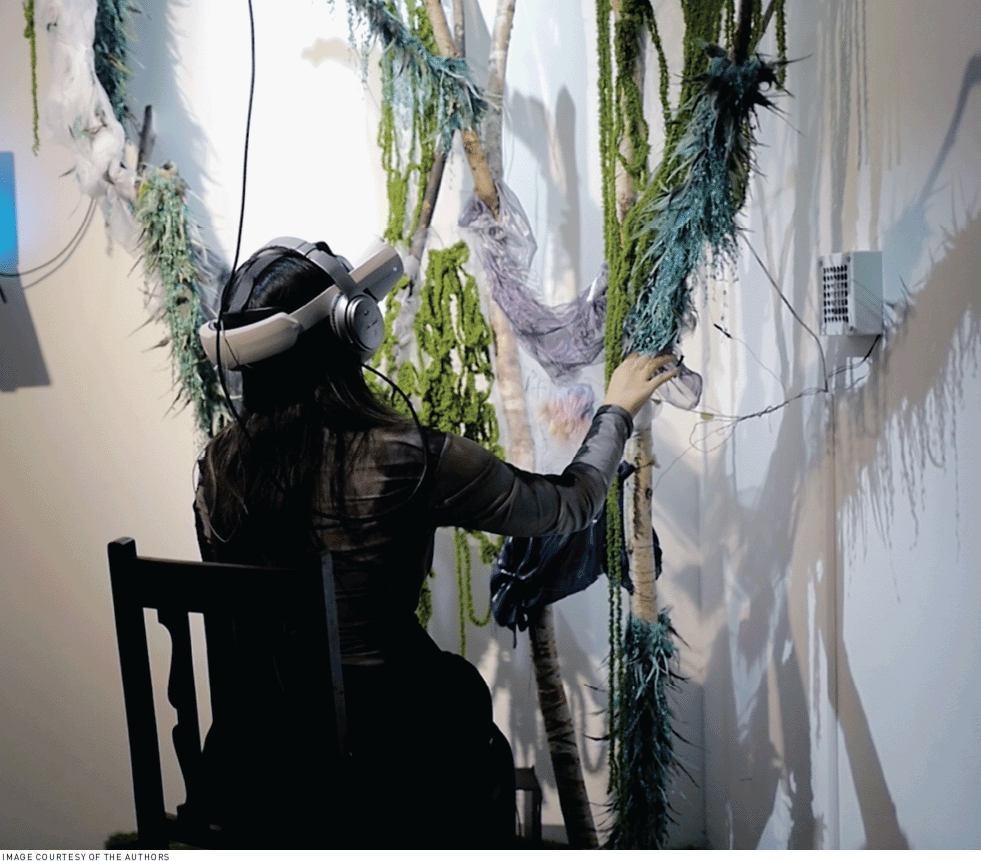 | Figure 1. The Sensing Nature installation. |
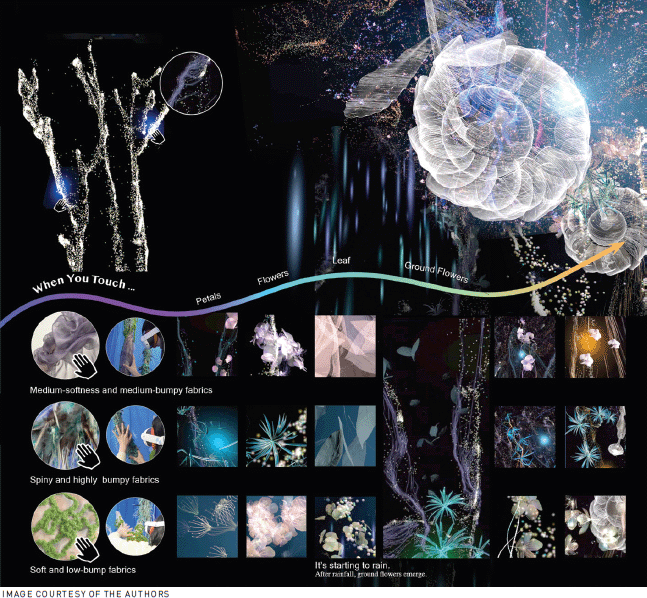 | Figure 2. The Sensing Nature installation includes several fabric textures that result in different visual and sonic interactions, including blooming flowers and falling leaves. |
They see an abstract virtual tree slowly form out of particles (Figure 3). They can reach out and touch this tree and feel the physical tree since the real and virtual trees are accurately registered to have the same location relative to the participant. As they touch the tree, they see virtual energy flows passing between themselves and the tree. The points they touch bloom into flowers. After a while, rain starts falling and flowers grow from the ground, nourished by the tree's nutrients. The tree itself grows, nurtured by the energy given by the participant. It eventually towers over the participant and fades away as the virtual sun sets.
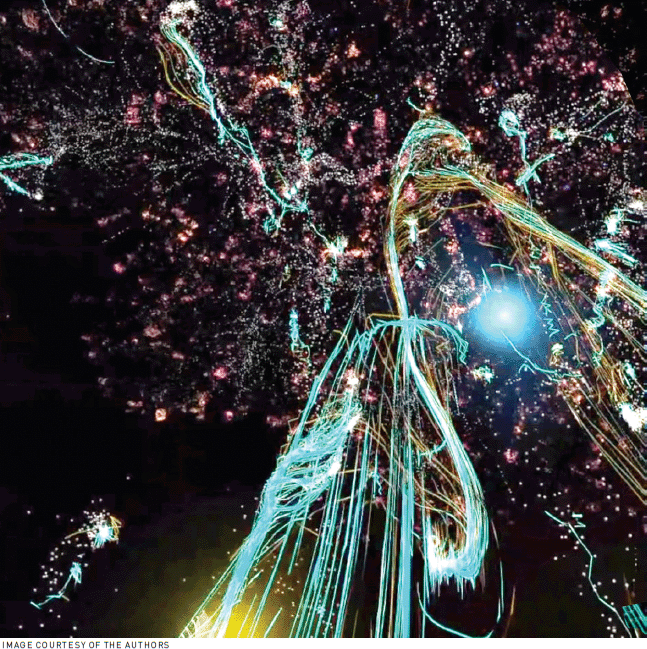 | Figure 3. The virtual tree with energy flowing up its trunk. |
The Sensing Nature installation allows people to experience the tree using multiple senses: the abstract visuals of the VR experience, the haptic feedback of the physical installation, and a musical soundtrack. Thus, the tree communicates with humans using human senses. We humans, however, also communicate using tree senses and communicate with the tree as a tree. The communication takes the form of direct touch, just as fungi directly touch the roots of a tree, and that touch results in abstract flows of energy representing the nutrients and neurotransmitters passing between a tree, fungi, and other trees. We are therefore able, through our human senses, to communicate with a tree in a very treelike way, with no anthropomorphism or human symbolism.
When we interviewed people who had experienced the installation, they readily interpreted the interaction in terms of energy flows. "Energy was transferred between the tree and myself," one said [6]. This, in turn, built their relationship with the tree: "I feel, like, the symbiotic relationship with the big virtual tree," and "I truly feel they're becoming my mom." Consequently, this stimulated them to connect with real nature: "After the experience, I would like to touch the real nature more, like lie on the grass or go out to touch it." These impacts show the potential for using VR to build sensibility to nature as nature, inspired by the ideas of Morizot and Zhong Mengual.
If, as Morizot proposes, our polycrisis is founded on a crisis of sensibility to nature, it is the responsibility of artists to help rebuild our sensibility to the more than human. Technological arts, including virtual reality, are well placed to do this. We currently lack enough awareness to connect to the more than human, but media, such as VR, are able to show us what is hidden in the living world. Sensing Nature allows participants to experience energy flows in plants and to experience them within our own sense of time, since we often miss the behavior of plants that are much slower than we are. This helps people feel more connected to real nature. We hope that VR artists and designers will take up our call to create art that is able to build sensibility to the more than human.
1. Morizot, B. Ways of Being Alive. Polity Press, 2022.
2. Lengieza, M.L., Aviste, R., and Richardson, M. The human–nature relationship as a tangible target for pro-environmental behaviour—guidance from interpersonal relationships. Sustainability 15, 16 (2023); http://bit.ly/4njzK1O
3. Zhong Mengual, E. Apprendre à voir: Le point de vue du vivant. Actes Sud, 2021.
4. Spangenberger, P., Freytag, S.-C., and Geiger, S.M. Embodying nature in immersive virtual reality: Are multisensory stimuli vital to affect nature connectedness and pro-environmental behaviour? Computers & Education 212 (2024), Article 104964; http://bit.ly/4mQA3RR
5. Simard, S. Finding the Mother Tree: Discovering the Wisdom of the Forest. Alfred A. Knopf, 2021.
6. Zhang, T. et al. Sensing nature. Proc. of the 2025 ACM Designing Interactive Systems Conference. ACM, 2025, 1–14; http://bit.ly/41y7osc
Marco Gillies is a professor at Goldsmiths, University of London, where he leads the master's program in virtual and augmented reality and the Social, Empathic and, Embodied Virtual Reality research group. [email protected]
Tianyuan Zhang is a London-based Chinese artist and researcher who works with technology and virtual reality, exploring ideas of multisensory interaction and connection to nature. She is a Ph.D. candidate at Goldsmiths, University of London. [email protected]
 This work is licensed under Creative Commons Attribution-NonCommercial-Sharealike International 4.0.
This work is licensed under Creative Commons Attribution-NonCommercial-Sharealike International 4.0.
The Digital Library is published by the Association for Computing Machinery. Copyright © 2025 ACM, Inc.
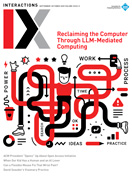
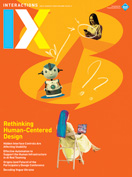
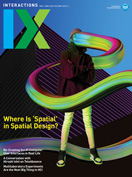





Post Comment
No Comments Found